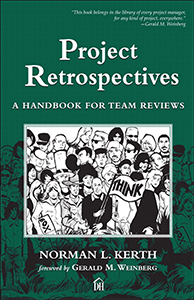
I had no clue
In my early days as an apprentice in the IT industry, as a software developer, later as a software architect and even as a team leader, I often wondered why it was so difficult for us to fulfill the wishes of management. Only later I realized that at that time probably nobody could have fulfilled them, because the wishes changed from day to day. At that time, management didn’t know what was important to them tomorrow, or they just couldn’t communicate it. In the beginning, I was still fooled into thinking that this is what agile meant - being able to respond to management’s wishes at any point in time. Who was I to question that. I didn’t visit university, I learned the theory in practice. Possibly I just didn’t understand the theory correctly.
It chased me and just wouldn’t leave me alone.
I guess it’s just the way it is. There’s nothing you can do about it! Or can you?
I began to question the theory and wanted to see for myself what is possible. One of the first books I read on leadership was ‘Managing Humans - Biting and Humorous Tales of a Software Engineering Manager’, by Michael Lopp. That was the first time, things seemed so clear to me. Much of what I have read in this book seemed familiar. On the one hand it was amusing that not only I have had this kind of experience, on the other hand it was shocking that there was such a kind of literature available for everyone who is even remotely interested in leadership - nevertheless we still go on like this.

I have to admit that I don’t know if I read it in one of the great books on leadership or if it just evolved over the years and many, many conversations with colleagues, but it is a quote that has stuck with me ever since:
It’s not about managing people, it’s about managing the environment that surrounds them.
Manage the environment
So what is the environment we are referring to here? I would say it is the team area, the system, the organization in general. The idea is to have a serve-first mindset and focus on empowering and developing people. We actively seek to develop and align an individual’s sense of purpose with the business goals. Servant leaders remove organizational impediments, in other words blockers. Do you have everything you need to get the job done? In other words, servant leaders clear the way for others to contribute.
After many more articles, blogs, and a few more fantastic books, I began to understand that the whole topic of leadership is probably a bit more complex:
- ‘The Five Dysfunctions of a Team: A Leadership Fable’, by Patrick Lencioni
- ‘Management 3.0: Leading Agile Developers, Developing Agile Leaders’, by Jurgen Appelo
- ‘Story Driven: You don’t need to compete when you know who you are’, by Bernadette Jiwa

I have tried to apply, try out and adapt what I have learned in different positions and different IT organizations. Some things worked well, some things didn’t.
But what has always worked was to communicate in a way that is polite, inspiring and motivating, even in an uncertain or changing environment. When responding with consideration to colleagues’ personal needs and feelings. When recognizing, valuing and communicating the achievement of goals.
Build trust
As a manager, you often seem untouchable to many employees. Some managers are hardly tangible for their employees. Their door is usually locked. Managers only leave their offices when the roof is on fire, at least that is how it appears to many.
Trust, but verify.
used by Lenin
So it’s not surprising that in many companies you notice as soon as managers take part in a meeting. It seems as if managers give a monologue - employees are not given the opportunity to contribute. They don’t question anything and withdraw.
At the beginning of my career I reacted similarly, then as a team leader I saw the other side and wondered why others reacted to me in the same way. There was a lack of trust, from both sides - at least that was the feeling at the time. We worked on it and it was great to see how the team grew together. To make it even more explicit, trust is always better than control!
In Lencioni’s pyramid, trust is the basis for everything, and I see it the same way. For building trust in your team culture, create an environment where you are open and honest, share problems, admit mistakes, and support each other.
A good first step for managers is to …
Don’t be a prick - Go first - Be human! Make yourself vulnerable.

But of course there were also conflicts in the team that we had to solve here and there.
Give a voice
Welcome productive conflict in your team. Encourage others to speak up, get input from the team and confront issues quickly. But remember, productive and constructive conflict cannot happen without trust!
With trust and healthy conflicts, you engage your team. This ensures that you are aligned on common objectives and being clear on direction and priorities. Team members should feel that they can take responsibility and hold each other accountable, even when it is difficult. Similarly, a high-performing team also recognizes the performance of others with praise or rewards.
Voice has a positive impact on organizational culture and is fostered by giving your teams more autonomy and trust.
Do retrospectives
Retrospectives, learning reviews, and post-mortems are team-based activities designed to learn systematically from past events in order to improve future performance. Delivery teams carry out retrospectives frequently and perform post-mortems or learning reviews after incidents.
As a developer myself, I have experienced post-mortems when errors occur in the system. Most of the time, the management started like this “Who caused this error again?”. Nice, isn’t it? Later I have seen that retrospectives were conducted, but the outcome was equally questionable. “What’s the point in doing retrospectives? It’s just a waste of time and I could use the time for something meaningful, like development.”, I have heard team members say.
Of course, these were not post-mortems or good retrospectives, but a pure blame-game without any meaningful learning.

Both the agile and operations communities emphasize the importance of making these activities blameless. Norman L. Kerth in ‘Project Retrospectives: A Handbook for Team Reviews’ proposes the idea of Retrospective Prime Directive which every participant should read at the beginning of a retrospective.
Retrospective Prime Directive
Regardless of what we discover, we must understand and truly believe that everyone did the best job they could, given what was known at the time, their skills and abilities, the resources available, and the situation at hand.
Norman L. Kerth, 2001
Learning reviews and retrospectives help contribute to a climate for learning, and also impact organizational culture. When teams conduct these reviews and retrospectives, they learn from their mistakes and failures and turn them into opportunities to improve their way of working.
In particular, teams that leverage their findings to implement changes to tooling, processes, or procedures see the strongest impacts.
For an in-depth look at learning reviews and retrospectives, see the 2018 State of DevOps Report.
Be transformational
Some of the challenges mentioned above have led me again and again to the Transformational leadership’s model. It combines many good aspects of leadership. The idea of the Transformational leadership model goes back to James MacGregor Burns in the ’70s. Burns described the difference between transactional and transformational leadership at that time.
Despite the great interest in transformational leadership, a number of theoretical problems have been identified with this model.
In the study Dimensions of transformational leadership: conceptual and empirical extensions (2004), published by Mark A. Griffin and Alannah E. Rafferty, aspects of transformational leadership theory were identified that led to a lack of empirical support for the hypothesized factor structure of the model and very strong relationships among leadership components.
They proposed five more focused subdimensions of transformational leadership, including vision, inspirational communication, intellectual stimulation, supportive leadership and personal recognition. Without a vision, we don’t know where to go. Lewis Carroll paraphrased this beautifully in Alice’s Adventures in Wonderland.
Alice: Would you tell me, please, which way I ought to go from here?
The Cheshire Cat: That depends a good deal on where you want to get to.
Alice: I don’t much care where.
The Cheshire Cat: Then it doesn’t much matter which way you go.
Alice: … So long as I get somewhere.
The Cheshire Cat: Oh, you’re sure to do that, if only you walk long enough.Lewis Carroll, 1865
Transformational leadership is a model in which leaders inspire and motivate followers to achieve higher performance by appealing to their values and sense of purpose, facilitating wide-scale organizational change. These leaders encourage their teams to work towards a common goal through their vision, values, communication, example-setting, and their evident caring about their followers’ personal needs.
It has been observed that there are similarities between servant leadership and transformational leadership, but they differ in the leader’s focus. Servant leaders focus on their followers’ development and performance, whereas transformational leaders focus on getting followers to identify with the organization and engage in support of organizational objectives.
The five dimensions of transformational leadership includes:
 Dimensions of Transformational leadership
Dimensions of Transformational leadership
(adapted from the 2017 State of DevOps Report)
- Vision: Has a clear concept of where the organization is going and where it should be in five years.
- Intellectual stimulation: Challenges followers to think about problems in new ways.
- Inspirational communication: Communicates in a way that inspires and motivates, even in an uncertain or changing environment.
- Supportive leadership: Demonstrates care and consideration of followers’ needs and feelings.
- Personal recognition: Praises and acknowledges achievement of goals and improvements in work quality; personally compliments others when they do outstanding work.
Good leaders build great teams, great technology, and great organizations. Transformational leadership enables practices that correlate with high performance, and it helps team members communicate and collaborate in pursuit of organizational goals. Such kind of leadership provides the foundation for a culture in which continuous experimentation and learning is part of everybody’s daily work.
The 2017 State of DevOps Report also takes an in-depth look at transformational leadership.
Conclusion
Today it still happens here and there that we cannot fulfill all the wishes of the management. The difference from when I started is that now I know proven principles and approaches, that help me deal with these situations. We now know how to handle these exceptional cases in true agile leadership and quickly work together to achieve our goals.